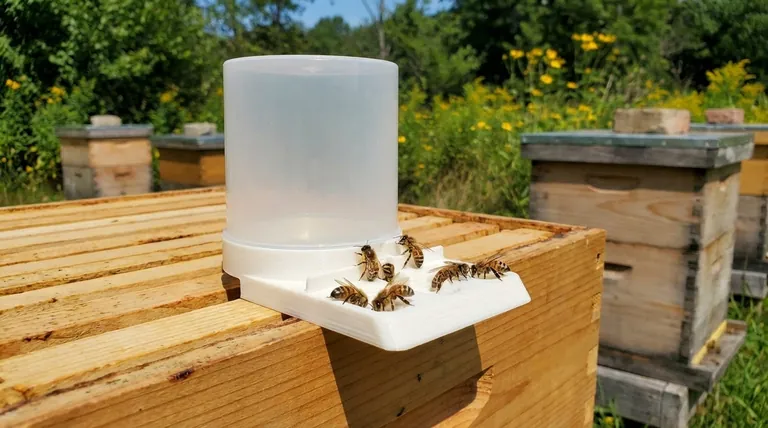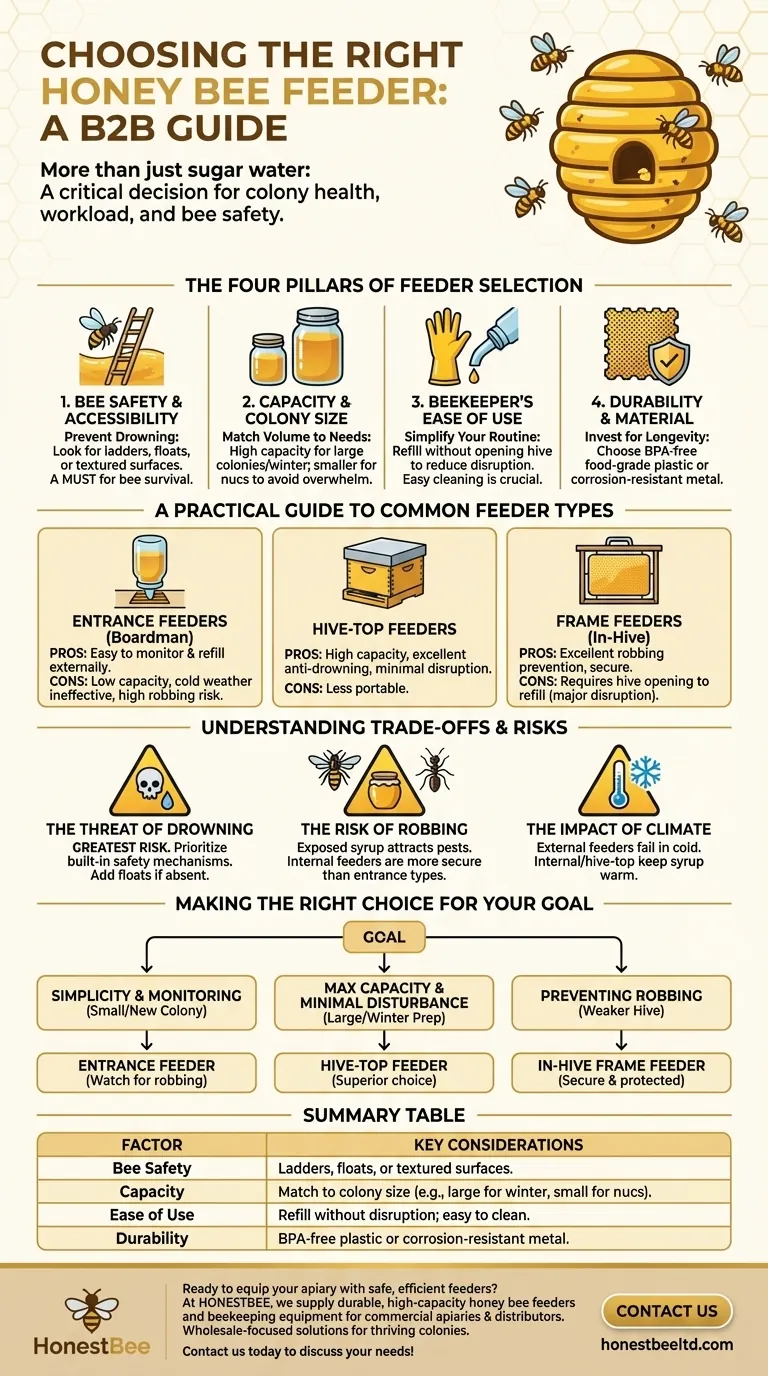Choosing the right honey bee feeder is about more than just delivering sugar water. It's a critical decision that impacts colony health, your workload, and the safety of your bees. The key factors to consider are the feeder's capacity relative to your colony size, its ease of use for refilling and cleaning, its durability, and, most importantly, design features that ensure your bees can access the food without drowning.
Your goal is not simply to provide food, but to support the colony's strength with minimal disruption and risk. The ideal feeder effectively balances the beekeeper's convenience with the bees' safety, preventing issues like drowning, robbing by other insects, and unnecessary exposure to the elements.

The Four Pillars of Feeder Selection
Before comparing specific models, it’s essential to understand the fundamental principles that define a good feeder. Every choice you make will be a trade-off between these four critical factors.
Bee Safety and Accessibility
This is the most important consideration. A feeder that drowns your bees is counterproductive and harmful.
Look for designs with ladders, floats, or textured surfaces that allow bees to climb out if they fall into the syrup. Open-trough designs without these features are a significant drowning hazard.
Capacity and Colony Size
The feeder's volume must match the colony's needs. A mismatch creates unnecessary work for you or fails to provide adequate nourishment.
High-capacity feeders are ideal for large, established colonies or for fall feeding when you need to provide a large volume of syrup for winter stores. Smaller-capacity feeders are suitable for new or small colonies (nucs) that could be overwhelmed by too much syrup.
Beekeeper's Ease of Use
A feeder you dread using is one you won't use consistently. Simplicity in refilling and cleaning is crucial.
Features that allow you to refill the feeder without opening the hive significantly reduce disruption and stress on the colony. This is a major advantage of entrance and many hive-top feeders.
Durability and Material
A feeder is an investment that should last for many seasons.
Choose feeders made from BPA-free, food-grade plastic or corrosion-resistant metal. These materials are easier to clean thoroughly and won't break down or leach harmful substances into the syrup.
A Practical Guide to Common Feeder Types
Different feeders are designed for specific locations on or in the hive. Each has distinct advantages and disadvantages that make it suitable for different situations.
Entrance Feeders (Boardman Feeders)
These simple feeders consist of a small plastic base that holds an inverted jar (typically a mason jar) at the hive entrance.
They are very easy to monitor and refill without disturbing the bees. However, their capacity is low, they perform poorly in cold weather, and they can easily incite robbing from other hives.
Hive-Top Feeders
These are high-capacity units that sit directly on top of the uppermost hive box, enclosed by an empty box and the outer cover.
Hive-top feeders hold a large volume of syrup and often include excellent anti-drowning features. Refilling them is simple and causes minimal disruption to the colony within the hive.
Frame Feeders (In-Hive Feeders)
A frame feeder is a thin, hollow container shaped like a standard hive frame. It hangs inside the hive body, taking the place of one or two frames.
Because they are located inside the hive, these feeders are excellent at preventing robbing. However, they require you to fully open the hive to check levels and refill, which is a major disruption.
Understanding the Trade-offs and Risks
No feeder is perfect for every beekeeper in every season. Understanding the potential downsides of each choice is critical for making an informed decision.
The Threat of Drowning
The single greatest risk with any feeder is drowning. Bees are not strong swimmers, and an open pool of syrup is a death trap.
Always prioritize feeders with built-in safety mechanisms. If a feeder doesn't have them, you must add your own, such as wooden floats, hardware cloth, or even wine corks to give bees a life raft.
The Risk of Robbing
The smell of sugar syrup is a powerful attractant for other honey bees, wasps, and ants.
Entrance feeders are the most likely to cause robbing because the food source is exposed outside the hive. Internal options like frame feeders and hive-top feeders keep the syrup contained and defensible.
The Impact of Climate
Your local climate and the current season dictate which feeders are practical.
External feeders are ineffective in cold weather, as the bees will not break cluster to access them and the syrup will get too cold. Internal and hive-top feeders keep the syrup closer to the warmth of the colony.
Making the Right Choice for Your Goal
The best feeder is the one that aligns with your colony's specific needs and your management style.
- If your primary focus is simplicity and monitoring a new, small colony: An entrance feeder is a good starting point in warm weather, but watch closely for robbing.
- If your primary focus is maximum capacity and minimal hive disturbance: A hive-top feeder is the superior choice, especially for large colonies or winter preparation.
- If your primary focus is preventing robbing and protecting a weaker hive: An in-hive frame feeder keeps the food source secure and protected from outside pests.
Ultimately, the right feeder is a tool that safely nourishes your colony while fitting seamlessly into your beekeeping routine.
Summary Table:
| Factor | Key Considerations |
|---|---|
| Bee Safety & Accessibility | Ladders, floats, or textured surfaces to prevent drowning. |
| Capacity & Colony Size | Match volume to colony needs (e.g., large for winter, small for nucs). |
| Beekeeper's Ease of Use | Refill without hive disruption; easy cleaning. |
| Durability & Material | BPA-free plastic or corrosion-resistant metal for longevity. |
Ready to equip your apiary with safe, efficient feeders? At HONESTBEE, we supply durable, high-capacity honey bee feeders and beekeeping equipment designed for commercial apiaries and distributors. Our wholesale-focused solutions ensure your colonies thrive with minimal risk. Contact us today to discuss your needs and boost your beekeeping success!
Visual Guide

Related Products
- HONESTBEE Entrance Bee Feeder Professional Hive Nutrition Solution for Beekeeping
- HONESTBEE Professional Hive Top Bee Feeder Feeding Solution
- Rapid Bee Feeder White Plastic 2L Round Top Feeder for 8 or 10-Frame Bee Hives
- In-Hive Dual Compartment Frame Bee Feeder for Targeted Colony Nutrition
- HONESTBEE Professional Entrance Bee Feeder Hive Nutrition Solution
People Also Ask
- How do you make an entrance feeder for bees? A Guide to Safe & Effective Hive Feeding
- What are the different types of honey bee feeders? Choose the Right Feeder for Your Hive
- What is the best feeder for bees? Choose the Right Feeder for Your Hive's Success
- How does the entrance feeder method work? A Guide to Simple But Risky Hive Feeding
- What is an entrance feeder? A Guide to Its Simple Design and High Robbing Risk



















